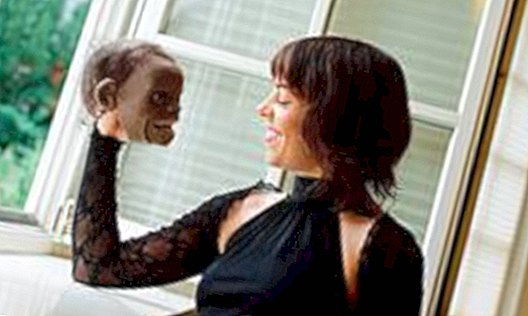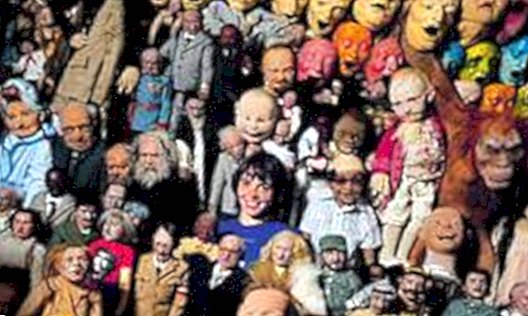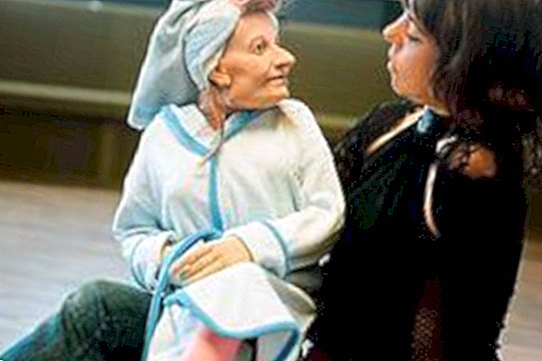The playful

The child is sitting on the edge of the stage. One was not prepared for it. A child that is not one. And his look, which is not one, makes one's blood run cold, so penetrating is he. The child speaks with a voice that does not belong to him, and the child breathes, but it can not do that at all. All that matters is this kindergarten, makes Suse Waechter, the woman who stands behind him. The puppeteer. As a spectator you can see this doll and understand: It is a doll. And you see Suse Watcher and know: She plays this doll. But something happens. It can not be said exactly when and how: Both merge. A separate being emerges, two become one, halfway between man and creature. That's the art. Such a doll irritated. The subscription audience sits in row 17 of the Thalia Theater in Hamburg and is taken by surprise. Even outraged, one did not go into the puppet show, but into the T-h-e-a-t-e-r.

But the slipping-on-the-chair-slipping becomes enthusiasm, a more intense contact with what happens on stage. A great fun. A former feeling with powerful contemporary proportions. That creates Suse Waechter. That's what their dolls do. She had to be persuaded until she could decide on this portrait. She would not have anything interesting to say about her art, she said. Nothing clever. The 39-year-old is the only puppeteer who shows her skills on big stages in Germany. Waechter plays in the Theater am Turm in Frankfurt, at the Volksbühne Berlin, in Basel, Graz and at the Thalia in Hamburg. Last year, she even gave a few of her dolls to the Salzburg Festival.
I am too much D-train for children's puppet theater.
Suse Waechter is one in which you should never think of a traveling theater, of awkward puppets in a cute setting, of torn children's eyes and "Are you all there?". She plays with such expectations? and blows it around our ears. "I'm way too much D-train for children's puppet theater," she says. There is nothing sweet about her creatures. Nightmare masks are. Frozen mental states sometimes, scary realistic. Caricatures of our own. The dolls can Brecht or Dürrenmatt or Wagner. Or revue. Change the costume to Turandot? Creator of the shopping worlds? then in? Peer Gynt ?. Their approximately 250 dolls are Waechters Ensemble, packed in dozens of boxes and housed in various cellars. There is no room in her apartment in Berlin-Prenzlauer Berg.
Not far from home, in the Ernst Busch drama school, still further to the east of the city, shows Suse Waechter her entire fund. Everything started here, shortly after the turn. Small and delicate, the artist appears between her creatures, which she spreads out on the floor, dangling over hangers, succulent, as if dead. She shows the Rhine daughters from the "Ring of the Nibelung", a substance as big as schoolchildren, and the little one Prehistoric, whom she has built last of all? "That was a dream of mine", a shaggy, red-faced something.

Suse Watcher in blue T-shirt, jeans and flip flops, loses herself in her world, dives. Pack up, pull something straight here, smooth out something there. Never get to a point. Quite different than when she is on stage. As rumbling, greint, she rages through the scenery. Powerful: In her pieces Suse Waechter pampers our expectations of the puppet theater with her heroines, the writer Elfriede Jelinek. What else do Suse Watchers and Muhammad Ali have in common? Ambition and Assertiveness Mostly in the shadow of their dolls and yet at the front. She is the playful, the playful. In her play "Heroes of the 20th Century" plays guard Trotsky, Lenin, the Dietrich and Marilyn Monroe, as Hitler sings her "airplanes in the stomach" by Herbert Grönemeyer. A total of 60 dolls makes them perfect copies of real people, watchers meets their dialects exactly, their pitch, their body language. In many scenes she works with two assistants on a doll at the same time? one leads the arms, one chest and head, the other arranges the feet. The dolls are just 40 centimeters tall. Mostly Suse Waechter takes over the main part? speak, head and center. "I want the doll bodies to move as complexly as possible, but you can not do that as an individual, but by giving her the voice, I have the most power over the puppet."
Dolls get a story, a soul

So is it about power? In the game? You can tell two stories for that. One: Suse Waechter has two older brothers. "If they caught in the river, I built a small fishing rod with a small hook on it, I wanted to have everything in small." You could also say: different. The second story: Suse Waechter says the myth of Pygmalion from Homer's Odyssey touches her deeply.It is the episode of a sculptor who creates a woman and brings it to life through his love and imploring the gods. "A creature that lives for you," says Suse Waechter and listens to her sentence for a moment, "I also want my sculptures to come alive, to breathe new life into them, so I absolutely identify with this story."
Suse Waechter did not want to become an actress. Because she did not dare. And: "Because I was very young, back then." And: "I was more of a provincial girl." Suse Waechter had an internship at the Erfurt Theater as a theater artist after graduating from high school. And after the fall of the Wall, she hired Salomé at the traveling circus and discovered the west with him. She was looking for the closeness to art, but somehow she scared her too. She preferred to stick to the craft, in the background. You have to allow what she tells you to let pass by, because later comes the crucial passage: "I'm just more of a parrot type, an imitator," says Suse Waechter. "I like to make voices and dialects, I love to turn myself into animals or people, and when it comes to acting, you have to show so much of yourself." She applied to the puppetry department. She met Tom Kühnel, who was studying in the directing class. Since their studies, they live and work together. Even her first piece together was a puppet show. She built each of her dolls herself and has meanwhile created complex movement machines.

How much human how much Suse Waechter is in every single doll? She thinks. Before every construction she does anatomical studies. Wondering how the character has to hold on stage later. "I try to simulate the consistency of the body, mostly with foam My dolls need to have a crumple zone around their skeletons Wood would have a nutcracker effect for me." She jumps up, makes "Augsburger Puppenkiste" to clarify what she means: comes with a labbig-fedrigem gear to one, the head slightly inclined, and leaves a few times her forearm like a fall ax; she is the perfect stand-up puppet. Then she shakes herself back into Suse Watcher. "Nah, the classic puppet theater is not for me."
Dolls can also be shackles.
She says she always has the view from the outside in her head. Of movements, scenes and sequences. "Like a comic book artist, I call that eye-sightedness, I know how the scene can work from the timing and the movements." Only sometimes does she use a video camera to help herself from the viewer's perspective. But Suse Watcher in every doll? "I'm not an esoteric." That's almost defiant. Someone else will find a good answer to the question. "Suses dolls," says Jürgen Kuttner, "are as complex as they are. Beautiful and disturbing, childlike and brutal." Waechters pieces are never pure puppet productions. She just wants to break the theater boundaries, let her bizarre creatures across the borders of their art form. Or, as she says, a bit cumbersome, "

Reanimate the possibilities of the masquerade and thus enrich the spectacle. "The actors interact with the puppets in dialogue, arguing, fighting with them, and the audience does not really know where to look: on the man, the doll or this A little energetic person behind it, anticipating the whole body's movements, sometimes it happens that Suse Waechter is unaccompanied, and now she even likes doing that. "Dolls can also be shackles, I give my hands away to the dolls , and that's a limitation. Like drinking boxing gloves. "
What is she really? Actress and puppeteer? Puppet maker? Puppenanimateurin? Puppeteer? Good question, says Suse Waechter thoughtfully, retreating for a moment. She lights a cigarette. Short train, back stretched, the big round eyes torn open. Her voice gains in depth again: "I do not like to call myself," she says. "I like the program note 'animation' instead of 'puppetry' because animation or soul-busting means 'getting closer' to what I want to do, so in the end I'm like that between the chairs. "
A bit in the shade, but in the front
Your sentences are spinning, gaining in self-confidence? but at the end there's another kick in the abyss. The watcher strategy: deep stacking, deep. There are many such phrases with which she retires. That's what she likes to do. Unstatement. Light off, finish. "I probably stopped at the dolls," she once said, almost by the way. Such a sentence gets stuck. Because he does not fit so well with this strong woman on stage. But at some point you get it: The guardian sentences have a meaning. They protect. So no one can do something. That's nice to her. And she can continue in peace. A little bit in the shade. But also at the front.










